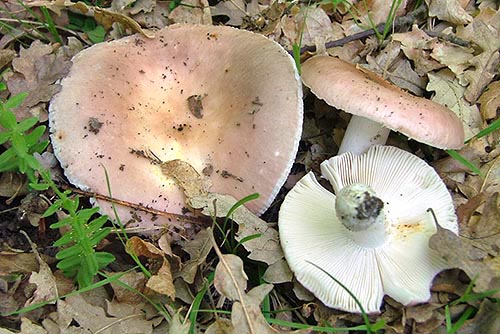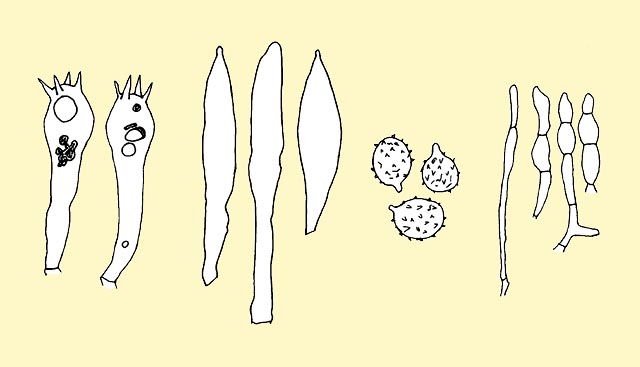
Text © Pierluigi Angeli

English translation by Mario Beltramini

Russula vesca © Pierluigi Angeli
Family: Russulaceae Lotsy 1907.
Genus: Russula Persoon 1796.
Subgenus: Hetrophyllidia Romagnesi 1987.
Section: Heterophyllae E.M.Fries.
Russula vesca E.M. Fries, 1836.
The name comes from the Latin “véscor”, I eat, to eat: edible.
The order of the Russulales is composed by fungi with firm or frail flesh due to its structure: with aggregations of sphaerocysts. Carpophores without ring and volva, often with bright colours, spore powder from white to yellow to ochre, spores with warty ornamentations, crested or reticulated, amyloid, with laticiferous hyphae.
Description of the genus
The genus Russula includes homogeneous fungi (the structure of the cap and of the stem is continuous, that is, they do not separate without breakage), without volva and without ring, where the main characteristic stands in the manner on how the flesh breaks: in a net way. This characteristic is due to the particular structure of the flesh which is formed by spherical cells (sphaerocysts). The flesh does not secrete any latex upon breakage. The fungi belonging to this genus are symbiont or mycorrhizal, this means that they are linked to arboreal or shrubby essences; therefore their growing environment will be mainly woody, or at most, clearings or wood margins.
Description of the species
Cap: 6-9 (11) cm, fleshy and firm, from globose to convex and finally flattened, depressed in the centre, the cuticle is separable for about one third of the radius, smooth, opaque, almost velvety, in the adult fungus it shrinks leaving the margin uncovered, margin at the beginning inrolled, smooth. The colour varies from pink-brown to wine-red, flesh-coloured or also pale chamois, the centre is darker with ochreous nuances.
Hymenium: adnate or slightly decurrent gills, thick, forked by the stem, almost lardy at the touch, frail, white or with a slight cream reflex, the edge stains often of rust.
Stem: 3,5-7 x 1,5-3 cm, almost cylindrical, somewhat attenuated at the base, initially full then spongy. The colour is white, at the base has some slightly yellow or brownish spots, the surface is smooth, later becoming rough.

Russula vesca basidia, cystidia, spores and pileipellis © Pierluigi Angeli
Flesh: firm, hard, frail, white, flesh-coloured under the cuticle of the cap; good smell, mild flavour.
Habitat: it grows both under hardwood and under coniferous from early spring up to autumn, very common.
Edibility: good edible.
Chemical reactions: to the ferrous sulphate (FeSO4): orange-red; to the guaiacum tincture: it reacts positively and rapidly.
Spores: egg-shaped, with isolated warts, white in mass, 6-8 × 5-6,3 µm.
Basidia: clavate, tetrasporic, without joint buckles, 42-52 × 8-10 µm.
Cystidia: fusiform, obtuse or ogival, 8-10 µm wide.
Cuticle: formed by septate and ramified hairs, with sporadic presence of dermatocystidia.
Remarks. It is a very common fungus and amply spread both in hardwood and in coniferous; it prefers soils moderately acidic or neutral, where it appears since the early spring.
It can be easily recognized by observing its characters: the flesh or brown wine-red colour, the whitish gills tending to get rust spotted when ripe and at times spread over the cuticle, the tendency to stain of yellow in the deteriorated parts and the intense reaction to the ferrous sulphate.
The Russula vesca can appear in various forms, which, in this case, concern only the colour of the cuticle of the cap, whilst all other characteristics, both macro and micro remain unchanged; they are: fo. viridata completely green olive; the fo. lactea completely white; the fo. avellanea brownish ochre, beige.
Synonyms: Russula heterophylla var. vesca (E.M. Fries) Melzer & Zvara (1927).
→ For general notions about Fungi please click here.
→ To appreciate the biodiversity of MUSHROOMS please click here.
